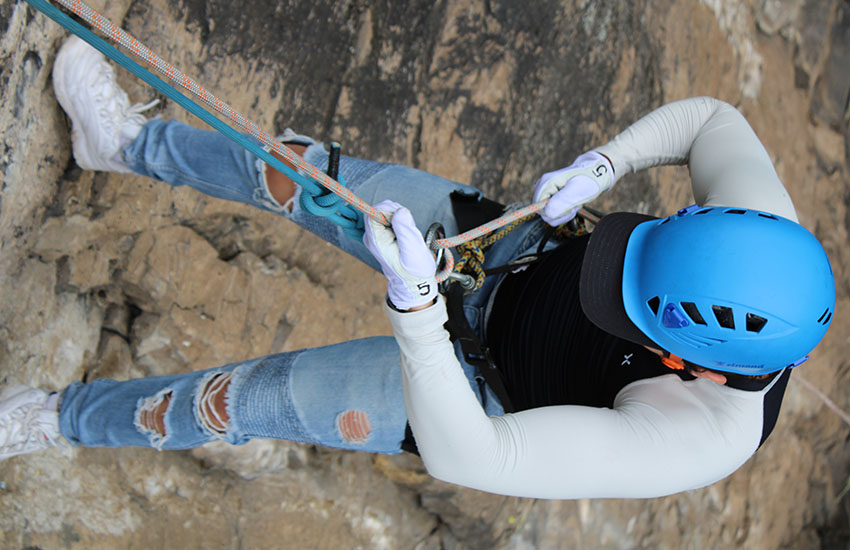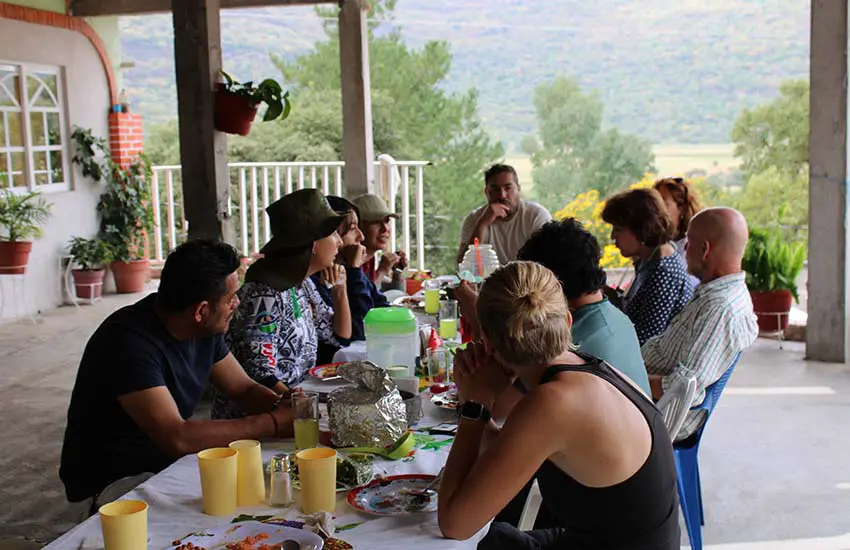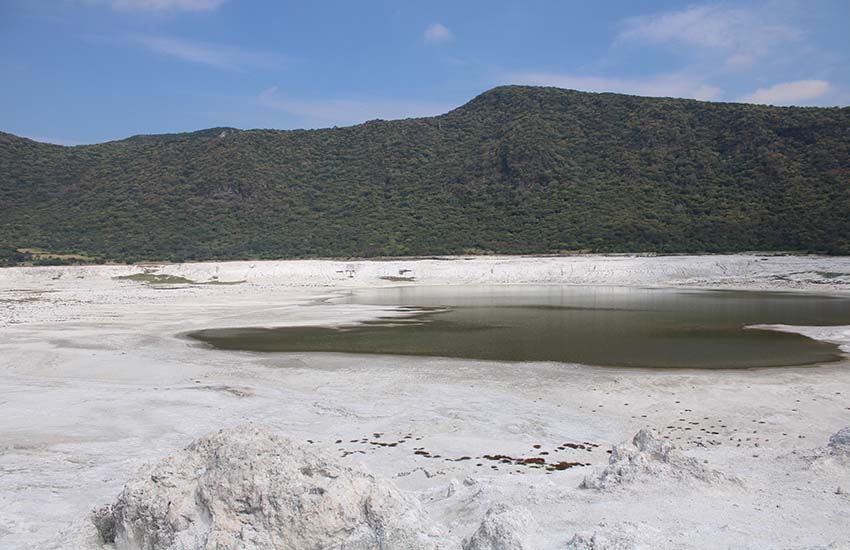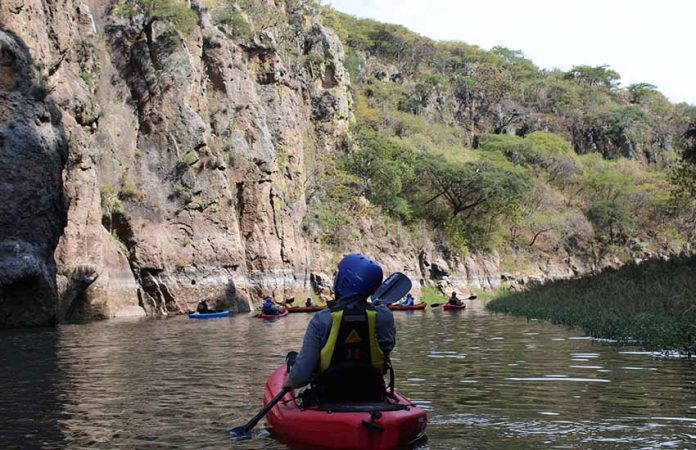The sun is rising over fields of late fall wildflowers in Guanajuato. Most of us are city slickers and not fully prepared for the chill of 8 a.m. in Tarandacuao, a town in the state’s southern lowlands, close to its border with Michoacán. Our flimsy jackets have us shivering over Blanca Estela’s oat atole, pozole soup and cafe de olla. Papel picado flags rustle in the cool breeze as we sit in the open dining room, fueling up for a day of kayaking with the Taranda Rafting company.
We are a group of travel agents and media folks, here to see what the state has to offer visitors, and while I lived in Guanajuato for almost five years when I first arrived in Mexico, this is a part of the country that I am completely ignorant of and eager to explore.
Our guide Pedro had planned for us to go river rafting today, but the water levels are too low, so we will be kayaking down a lower section of the Río Lerma instead.
We’re divided up among those who can swim and those who can’t with the most hesitant kayakers placed in inflatable double kayaks that are almost impossible to flip.

We take off, expecting wild (or at least quick) rapids, attacks from tree branches and impossible currents but instead find ourselves lazily floating past farmers with their cows out for a morning graze. Migratory birds are flying away faster than the currents that swirl around us.
By mid-trip, helmets have found their way into the bottoms of boats and shoes are optional.
The Río Lerma is the longest river in Mexico, stretching from México state all the way to Lake Chapala in Jalisco. It’s one of Mexico’s most important bodies of water, generating electricity and providing drinkable water to Mexico City and other metropolitan areas. In the past few years, the river has been a cause of concern for many environmentalists and farmers that depend on it, in that it is often the recipient of illegal dumping by the industries that surround it.
Still, it remains a favorite location for water sports, and our guides assure us that this part is very clean.
After about four hours, we are wet and sunburnt, watching from the shore of the Presa Solís (Solis Dam) as the final kayak makes its way across the water with two of our more cautious paddlers. We make bets on which is slowing the other down.
That night, we salute a day of “wild” rapids and chow down on grilled arrachera steak and Spanish sausage at the Parilla del Vaquero, a local hangout with families and groups of friends settled around outdoor tables and caguama beers. A trio of musicians plays to a table of very drunk men, one of them with his head in his hands, undoubtedly thinking about lost love and regret.
The following day, we are back on Presa Solís, our goal for the day being to reach the 150-meter-high canyon on the presa’s other side, then paddle in for several kilometers.
Our slow paddlers have now been separated, so we are about to see which of the two is the lead anchor, and as one sets out on his own, easily keeping up with the group, it’s pretty clear.
Our guide Rodrigo tells us that normally, we’d be able to float 6 or 7 kilometers into the canyon. But the water is extremely low because farmers are watering their crops at this time of year. It seems probable Mexico’s nationwide drought this year also has something to do with it.
Along the canyon walls and high on the trunks of the bald, white trees that sit in the water, the normal water line was 3 to 4 meters higher than it is now. The canyon shivers with the legs of spiders weaving massive webs along the rocky crags, butterflies chasing each other in the sun and the subtle dance of the lenteja aquatic plants shifting around our boats.
It’s a place that silences everything – everything that is but the two older ladies in our group that chatter on about the prices of an Uber in Cleveland and their favorite restaurants in Denver. Everyone else paddles past their incessant conversation marveling at the otherworldly ambiance of the tree graveyard that we are floating through, shifting from hot to cold under the canyon walls’ shadows.
It’s obvious that most everyone is reluctant to return to shore, and the trip back is a long haul in the blazing sun against the current. Still, the wide-open landscape is breathtaking, and the sky a cool, cloudless blue.

That evening, we land in Valle de Santiago, one of Guanajuato’s larger towns. Our guide from EcoValle Tours tells us that its gorgeous cathedral is second in height only to the cathedral in San Miguel de Allende. The area’s famous seven extinct volcanoes, called the Siete Luminarias, are said to hold mystic and spiritual powers. Devotees arrive each year to perform rituals and meditate in these monster holes left in the landscape.
We get a quick spin around town and then off to a pulque tasting at the Pulquería Tallacua, set inside a 19th-century home. Awaiting us is a beautiful al fresco table laden with pumpkins, purslane and other bounty common to this region.
Julio César Aquilar, the master pulquero, explains to the group how pulque — a fermented drink made from agave sap — is made and processed at their pulqueria. He passes around various versions of the drink, from its least alcoholic version to its most (not many pulques reach over 8% or 9% alcohol) and asks the group to notice the subtle flavors within this ancient elixir — indigenous peoples were making it before the Spanish arrived.
Extremely knowledgeable and informative, Aquilar is not fond of questions that distract from his one-man show. It’s better to sit quietly, sip your pulque and enjoy the fresh quesadillas hot off the grill.
The following day, we head out to visit two of the seven craters.
The first, Rincón de Paranguero, is accessible through a tunnel that was dynamited by local miners in the 1900s. The crater is a massive swath of white, bleached by the salt and other minerals that lay at its depths. Our guide tells us that, according to researchers from Mexico’s Autonomous University (UNAM), the crater’s bottom is home to stromatolites, believed to be Earth’s oldest life-forms. The next crater: the Hoya de Álvarez, is the exact opposite: its 1.2-kilometer floor is covered in bright-yellow-tasseled corn and gray-green agave plants.
The community here is made up of only about 30 families, and they are in many ways isolated from the outside world. With no public transportation and most of the men gone to work in the United States, the community’s women are a force to be reckoned with, maintaining the local school and supporting their families with tourism to the area. Several cabins sit on the edge of town to house the hikers and climbers that take advantage of the high crater walls.
Exactly what we are doing today, most of us for the first time — rappelling down a 30-meter rock face.
While it looks benign from below, once we are at the top and strapped in to our various lines, my stomach drops to the bottom of the valley floor. Felipe, the rappel master, assures us that in all his years doing this, he has never lost a single person, but hovering over the 30-meter drop it feels less than reassuring.
The actual rappelling part is only about 10 meters, and then you are basically lowered to the ground in slow motion as you gently twist on the line. Once I stop panicking, the view over the crater valley is absolutely breathless and worth every minute that I thought I might die.
When everyone is safely on the ground, we have lunch at a local home with a terrace that overlooks that same beautiful valley, tasting regional salsa and fried pork in chile guajillo ancho sauce with yellow Mexican rice and slippery paddles of grilled nopal cactus. In love, I turn to a friend on the trip and say I could stay here forever; she responds with a raised eyebrow, as if to say, “you’d likely last a week.”
As we head to Guanajuato city for the end of our trip, I am left with the sensation that there is a lot more to Guanajuato that I had realized in my years in the high desert, in the central part of the state. That there could be canyons and craters and wild(ish) rivers here was not something I was expecting.

Like a previous year’s trip to Chiapas, where I was struck by pristine beaches in a place never considered a beachgoers’ paradise, I was reminded that even after 15 years in Mexico, there is still so much to discover.
I made a mental note to come back.
Lydia Carey is a freelance writer and translator based out of Mexico City. She has been published widely both online and in print, writing about Mexico for over a decade. She lives a double life as a local tour guide and is the author of Mexico City Streets: La Roma. Follow her urban adventures on Instagram and see more of her work at www.mexicocitystreets.com.
